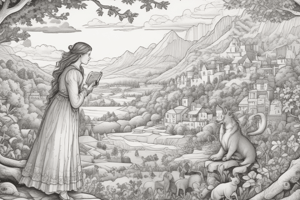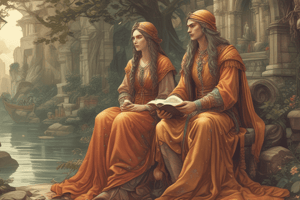Podcast
Questions and Answers
Who has taken Lear and Cordelia captive and put them in jail?
Who has taken Lear and Cordelia captive and put them in jail?
- Albany in order to keep himself safe
- Cornwall in order to show power
- Edgar to show his authority
- Lear and Cordelia have been taken captive by Edmund. (correct)
Which point of view allows the narrator to have access to the thoughts and feelings of multiple characters?
Which point of view allows the narrator to have access to the thoughts and feelings of multiple characters?
- Third-person omniscient (correct)
- Third-person limited
- Third-person objective
- First-person
Who says the following quote. "No, no, no, no! Come let’s away to prison! We two alone will sing like birds i’th’cage."
Who says the following quote. "No, no, no, no! Come let’s away to prison! We two alone will sing like birds i’th’cage."
- Albany
- Lear (correct)
- Edgar
- Kent
What is the term used to describe an object, color, or element that represents an abstract idea or concept?
What is the term used to describe an object, color, or element that represents an abstract idea or concept?
What happens to Cordelia while she is in prison?
What happens to Cordelia while she is in prison?
What is the correct POV term used to describe the narrator's perspective from within the story?
What is the correct POV term used to describe the narrator's perspective from within the story?
What is the term used to describe the language used to create vivid sensory experiences for the reader?
What is the term used to describe the language used to create vivid sensory experiences for the reader?
Who is left to rule the kingdom at the end of the play?
Who is left to rule the kingdom at the end of the play?
What is the term used to describe the process of comparing and contrasting characters to highlight their differences?
What is the term used to describe the process of comparing and contrasting characters to highlight their differences?
Who says the following quote, "Howl, howl, howl! O! you are men of stone!…She is gone forever."
Who says the following quote, "Howl, howl, howl! O! you are men of stone!…She is gone forever."
What is the purpose of the Fool's constant companionship to Lear in Act 3?
What is the purpose of the Fool's constant companionship to Lear in Act 3?
In Act 4, what is the significance of the reconciliation between Cordelia and Lear?
In Act 4, what is the significance of the reconciliation between Cordelia and Lear?
What motivates Edmund's betrayal of his brother and father in Act 3 and 4?
What motivates Edmund's betrayal of his brother and father in Act 3 and 4?
What is the outcome of Gloucester's failed attempt to help Lear in Act 4?
What is the outcome of Gloucester's failed attempt to help Lear in Act 4?
What is the significance of the final scene in Act 5, where Lear mourns over Cordelia's dead body?
What is the significance of the final scene in Act 5, where Lear mourns over Cordelia's dead body?
What is the consequence of Lear's decision to divide his kingdom among his daughters?
What is the consequence of Lear's decision to divide his kingdom among his daughters?
What is the role of the storm in Act 3?
What is the role of the storm in Act 3?
What is the significance of Gloucester's blindness in Act 4?
What is the significance of Gloucester's blindness in Act 4?
What is the outcome of Regan and Goneril's plot against Albany in Act 4?
What is the outcome of Regan and Goneril's plot against Albany in Act 4?
What is the significance of Cordelia's death in Act 5?
What is the significance of Cordelia's death in Act 5?
In Act 3, what is the significance of the storm that Lear and his followers encounter?
In Act 3, what is the significance of the storm that Lear and his followers encounter?
What motivates Goneril and Regan's cruel treatment of Lear in Act 4?
What motivates Goneril and Regan's cruel treatment of Lear in Act 4?
In Act 5, what is the significance of Lear's reconciliation with Cordelia?
In Act 5, what is the significance of Lear's reconciliation with Cordelia?
What is the consequence of Edmund's betrayal of his brother and father in Acts 3 and 4?
What is the consequence of Edmund's betrayal of his brother and father in Acts 3 and 4?
What is the significance of Gloucester's blindness in Act 4?
What is the significance of Gloucester's blindness in Act 4?
Flashcards are hidden until you start studying
Study Notes
Novel Analysis
- Plot Structure: typically consists of exposition, rising action, climax, falling action, and resolution
- Themes: underlying messages or ideas explored in the novel, often conveyed through character development, plot, and setting
- Symbolism: objects, colors, or other elements that represent abstract ideas or concepts
- Imagery: language used to create vivid sensory experiences for the reader
- Characterization: methods used to develop and reveal character traits, including:
- Direct Characterization: author explicitly describes character traits
- Indirect Characterization: character traits revealed through actions, dialogue, and thoughts
- Point of View: perspective from which the story is told, such as:
- First-person: narrator is a character within the story
- Third-person limited: narrator is outside the story, but only knows thoughts and feelings of one character
- Third-person omniscient: narrator has access to thoughts and feelings of multiple characters
- Third-person objective: narrator has no access to character thoughts or feelings
Character-Development
- Character Types:
- Protagonist: main character, often hero of the story
- Antagonist: character opposing the protagonist
- Supporting characters: add depth and complexity to the story
- Character Traits:
- Physical traits: appearance, age, and other physical characteristics
- Personality traits: emotions, values, and behavior
- Psychological traits: mental and emotional states, such as fears, motivations, and desires
- Character Development Techniques:
- Character growth: characters change or learn over the course of the story
- Character contrast: characters are compared and contrasted to highlight their differences
- Character foils: characters that contrast with the protagonist to highlight their traits
- Character Analysis:
- Character motivation: reasons behind a character's actions and decisions
- Character conflict: internal or external conflicts that characters face
- Character relationships: interactions and dynamics between characters
Studying That Suits You
Use AI to generate personalized quizzes and flashcards to suit your learning preferences.



